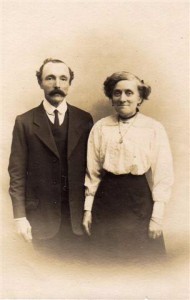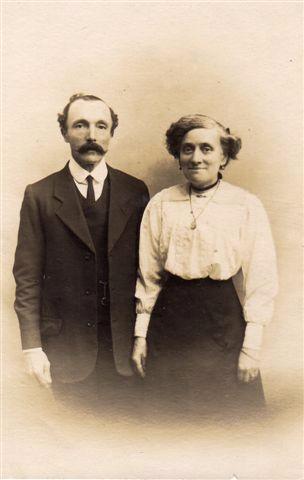By Arthur Woodgate
Many members of the Bryant family lived over the Sluice, either in Western Place or like me close by, so I claim that side Bryant, one of Rye’s top runners, second only to the great Shooty shoebridge of Rye Harbour, was one of us, and the Bryants were part of the builders or Rye as we know it today.
If any old Ryer thinks of the name of Bridger, they must think of Tim Bridger who was in his prime, Rye’s top amateur footballer, but he never went on to become a professional, although the town did produce one professional in the person of Fred Boreham, who played for Tottenham Hotspur. I don’t know if Tim ever lived over the sluice but there is no doubt that two members of that great family did. George and Mrs Bridger did live in Western Place and I looked on Mrs Bridger as the matriarch of Western Place, for it was always she who seemed to speak for the whole of the inhabitants, and she had an authoritative look about her.
So when some moved into Kings Avenue after the 1st World War and the rest into Tilling Green after the 2nd. under the slum clearance act, it was Mrs Bridger who explained to the borough surveyor how grateful they were to now have fresh air round them and gardens to look after as well as modern circumstances in the house, (it was Nye Bevan responsible at that time in the Attlee Government, who said there should not be more than eleven houses to the acre). There has been some in filling since.
There was no pub over the sluice, but Smeatons Stores remains, although now as a private house, for many years a Mr Huxstep was licensee and retailer, as it was an off licence and general shop. To go back further in local history, I can just remember, the previous landlord Mr Lampkin was an interesting man as he still wore the old working class dress of a long white smock, black scarf and little round black hat. I knew him in his retirement as he then lived in Cadborough View, which was still over the sluice. He and Mrs Ellis who still wore her Victorian dress of long black frock, under which was a red flannel petticoat and a bonnet like that we see in pictures of Queen Victoria. If one wonders how I knew of the petticoat, is was because these two sporty elderly personalities enjoyed lending me, as a teenager to enter fancy dress events, and I won a prize or two at it.
Moving westward from Smeatons Store we pass a few ordinary houses and come to Gladstone Terrace the name of which dates it to one of Victorias great prime ministers, these houses were occupied by ordinary people of their period and I will mention just two of the hard working men of those years. Bill Bannister was a baker and he worked at The Tower Bakery (next door to Landgate arch). He walked each day what amounted to from one edge of the borough and back. He also found time to play a trombone in the Rye Town Band, which did quite alot to entertain and help charity.

In the middle of Gladstone Villas lived one of the families of Woods who went to form the colourful characters over the sluice. The head of this family was Harry, a small man but very easily heard. He was obviously a seafaring man, but the freight ships out of Rye lessened and the fishing dropped off, so he was forced to join we land lubbers to earn a living. He was mate to my Grandfather on the fishing smack for a long time, and later found himself bringing me bricks and mortar, and because of that I got to know more about my material Grandfather than I might have done. The role that I like to remember Harry by is that he was one of Rye’s twentieth Century Stevedores, and I can see him now (in my memory) pushing 5 cwt. (don’t know what that is in Latin) barrows of coal across the narrow plank and into the gasworks or dancing up and down on a narrow plank with a length of timber on his shoulder, which he took into Hinds Timber Yard there could not have been a more active and useful man anywhere.
Then we came to what I always knew as Hayles’ Market garden together with a house, in which Mr Hayles lived. I have always been puzzled by this corner of Winchelsea Road, because the Market Garden and house were surrounded by Wool stores of Proctor and Gamble. However I like to draw a picture of great wool activity, with Western House involved, because our scout Club Room in Western House was what could well have been another Wool Store over the stables of the horses then used for the transport of wool and Western Place could well have supplied some of the labour at almost slave wages.
Of the other Wood family of the Area, the most interesting was James Henry Wood. He put many bricks into the houses of New Winchelsea Road (silly name) when he worked for Jack Ashenden, a leading builder at that time. When J H Wood was released from a prisoner of war camp he set to building his own bungalow between Western House and the Martello Tower, and from that stepping stone he took on building work for other people, and the firm of J H Wood added quite a lot of Rye’s building stock including Fairmeadow and from his headquarters in West Undercliff, his staff also went out to improve and increase the building capital well belong the Borough boundary, and he was a good employer, and of this I’m not guessing because for a few years I was one of his well treated employees unfortunately he died in his fifties and the firm wound up not long after, a great pity for Rye’s economy.
Finally on that side of the Martello Tower formed a great bastion to the Western end of over the sluice, on that side, but it has been pulled down, another great pity.
Over the road, between the coal wharf and the start of the Harbour Road, various businesses have come and gone and although he only had a work place there George Wake added some colour. He had travelled round the country improving himself as a young plasterer, and arrived in Rye to help build Lloyds Bank. He decided to stop in Rye and married and settled in Tillingham Avenue in 1899. I got to know him very well, and in view of all the rubbish being banded about that we mere humans can alter the climate, I record a story he told me about when he was in London in the late 19th Century, the Thames froze over and they lit bonfires on it and had parties round them he didn’t say the dismal jemmies were saying that they were doing something to cause a new ice age, bit I bet they did.
However George established a cast stone business, so cheering that part of the sluice up with statues and monuments which he had himself moulded and cast. He died, aged 80 whilst making an after dinner speech at a function.
We are now at the junction leading to Rye Harbour and in corner, where a boat yard now is, there was a huge stack of old iron. This belonged to the Gasson Empire and we kids discovered there were parts of the early Ford motors in this heap, in the form of powerful magnets, so we took them, tied a piece of string on them and pulled them around the streets to pick up the iron filings from the horseshoes, as many horses were still around in that period of change from horses to the internal combustion engines. A historical time to have been privileged to live in as it was one of the great periods of worlds change in our way of living in spite of two World Wars. It was better, we got fed up with playing with the magnets and took them to Gassons office in Wish Ward and they would give us a copper or two, although I’m sure they knew what was going on. I felt unhappy about this not that I was frightened of the Gassons or the Police, but had a Victorian born and Flanders hardened Father who was also a strong member of the Methodist Church (todays children would not understand what I’m talking about) The old iron was loaded into German boats that had brought us timber from the Baltic, taken back to Germany and within a few years given back to us in the form of bombs.
I claim that the once looked down on area of Over the Sluice together with The Strand was one of if not the greatest asset of our Ancient Town during the 20th Century, and if other areas such as Rock Channel or Landgate disagree, let them challenge it with their own records, so that our local history of this period will not be lost.
“Rye’s Own” August 2006
All articles, photographs and drawings on this web site are World Copyright Protected. No reproduction for publication without prior arrangement. © World Copyright 2015 Cinque Ports Magazines Rye Ltd., Guinea Hall Lodge Sellindge TN25 6EG
